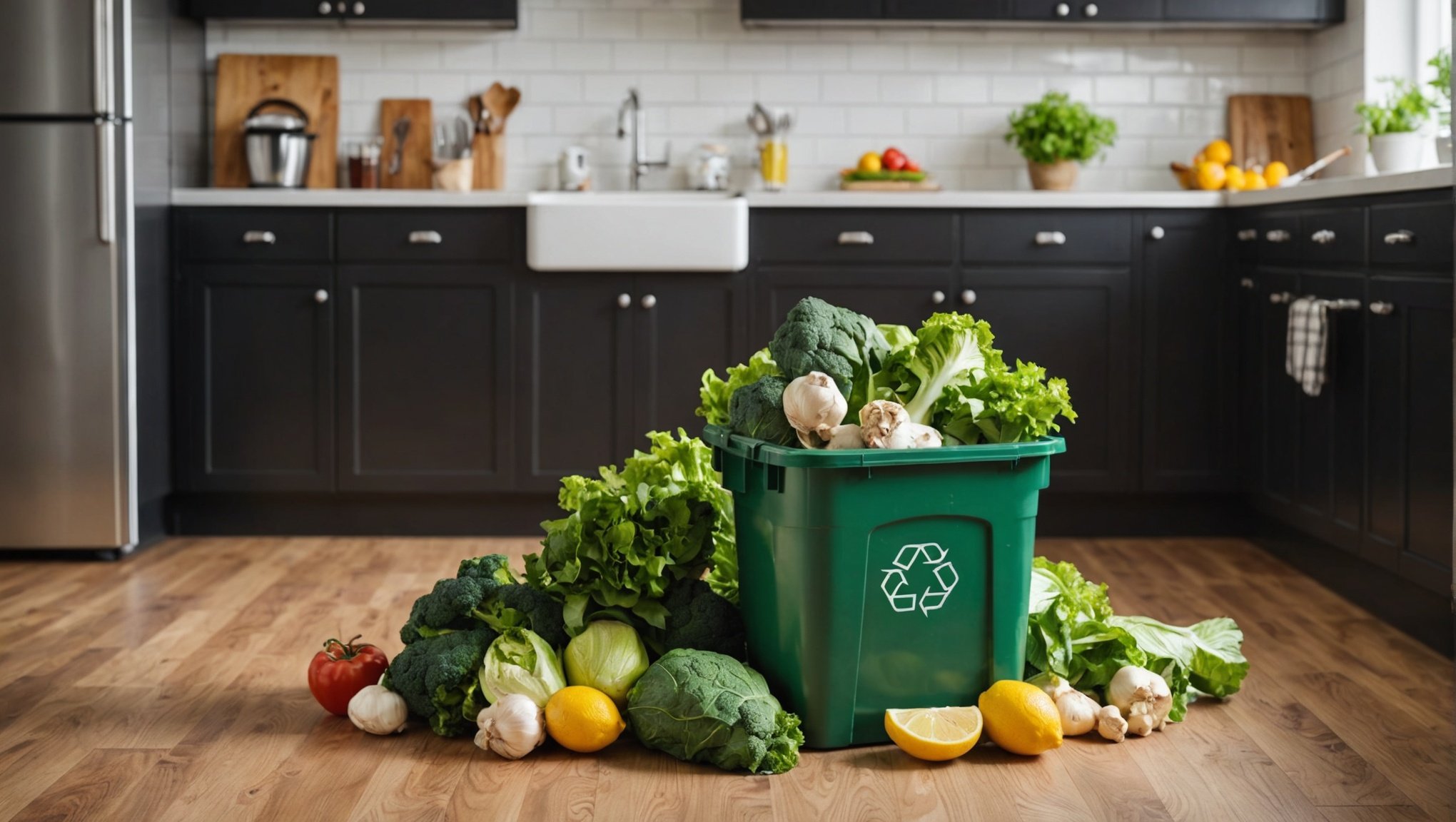Mounting kitchen waste poses a significant challenge, but effective recycling strategies can turn your trash into treasure. By implementing practical approaches, you can reduce your environmental impact while benefiting your household. This comprehensive guide reveals innovative techniques for repurposing kitchen waste, from composting to creative reuse. Discover how small changes can lead to substantial benefits, making your kitchen greener and more sustainable—one scrap at a time. Embrace these strategies to transform your waste management habits today!
Understanding Kitchen Waste Recycling
Kitchen waste recycling is a crucial aspect of sustainability and effective waste management. It involves processing organic waste, such as fruit peels, vegetable scraps, and coffee grounds, which are common in households. By recycling these materials, we significantly reduce the volume of waste sent to landfills, which helps mitigate harmful environmental impacts.
This might interest you : Transform Your Kitchen: How Smart Home Assistants Like Alexa and Google Home Revolutionize Diet Management
Kitchen waste recycling plays a vital role in decreasing the production of methane, a potent greenhouse gas emitted from decomposing organic matter in landfills. By diverting kitchen waste from landfills, we can lower methane emissions and contribute to a healthier planet. Additionally, recycling kitchen waste supports soil enrichment. Composting, a popular method of recycling kitchen waste, transforms organic scraps into nutrient-rich compost, which can improve soil quality and promote plant growth.
The environmental benefits of effective kitchen waste management extend beyond reducing landfill impact. It conserves natural resources by returning valuable nutrients to the soil, reducing the need for chemical fertilizers. Furthermore, it promotes sustainability by encouraging responsible consumption and waste reduction practices.
Have you seen this : Transform Your Kitchen: How Smart Home Assistants Like Alexa and Google Home Revolutionize Diet Management
By understanding and implementing kitchen waste recycling techniques, individuals can contribute to a more sustainable future, minimising their ecological footprint and fostering a cleaner environment for generations to come.
Strategies for Sorting Kitchen Waste
Sorting kitchen waste efficiently is essential for effective waste management and maximising the benefits of kitchen waste recycling. Implementing a robust system can simplify this process and enhance your recycling efforts.
Identifying Recyclable Materials
Understanding what qualifies as recyclable is the first step. Common recyclable materials include fruit peels, vegetable scraps, and coffee grounds. These items are ideal for composting, as they break down into nutrient-rich soil. However, avoid placing meat, dairy, or oily foods in your compost bin, as these can attract pests and slow down the decomposition process.
Creating a Waste Sorting System
Having a dedicated space for sorting waste can streamline your recycling routine. Consider setting up separate bins for compostable waste, recyclables like plastics and metals, and non-recyclables. Clearly label each bin to prevent confusion and ensure proper sorting. This system not only organises your kitchen but also encourages responsible consumption habits.
Best Practices for Waste Segregation
To optimise waste segregation, regularly educate yourself and family members on recycling tips. Practice rinsing recyclables to remove food residues, and flatten cardboard boxes to save space. By adhering to these best practices, you enhance the efficiency of your waste management system and contribute positively to environmental sustainability.
Benefits of Recycling Kitchen Scraps
Recycling kitchen scraps offers numerous benefits, significantly contributing to sustainable living and reducing waste. One of the primary advantages is the economic benefit. By recycling organic waste, households can reduce their reliance on commercial fertilisers, which can be costly. Instead, nutrient-rich compost made from kitchen scraps can be used to enrich gardens and potted plants, promoting healthier growth at no extra expense.
Moreover, recycling kitchen waste plays a pivotal role in supporting community sustainability efforts. Many communities have established composting programs that rely on residents’ participation. By contributing kitchen scraps, individuals help create a collective resource that benefits local agriculture and green spaces. This communal approach not only fosters environmental stewardship but also strengthens community bonds.
The nutritional benefits of compost derived from kitchen scraps are also noteworthy. This compost is rich in essential nutrients like nitrogen, phosphorus, and potassium, which are crucial for plant health. Using compost in gardens can enhance soil structure, improve moisture retention, and increase crop yields. Thus, recycling kitchen scraps not only supports sustainable living practices but also promotes a thriving garden ecosystem, ultimately leading to healthier food options for households.
DIY Composting Techniques
Exploring different composting methods can enhance your kitchen waste recycling efforts. By engaging in DIY composting, you can transform organic waste into valuable compost at home.
Basic Composting at Home
Starting with basic composting tips, you need a balance of green and brown materials. Green materials include fruit peels and vegetable scraps, while brown materials encompass dried leaves and cardboard. Ensure the compost pile stays moist but not soggy, and turn it regularly to aerate. This method is straightforward and ideal for beginners.
Bokashi Composting Method
The Bokashi composting method is an anaerobic process that uses a special bran to ferment kitchen waste. This technique is efficient for those with limited space, as it requires only a sealed bucket. After fermentation, the waste can be buried in the garden, enriching the soil with nutrients.
Vermicomposting for Beginners
Vermicomposting utilises worms to break down organic matter, producing nutrient-rich castings. It’s perfect for small spaces and can be done indoors. To start, create a worm bin with bedding material like shredded newspaper. Add kitchen scraps gradually, and maintain moisture levels to keep the worms healthy. This method provides a continuous supply of compost.
Creative Uses for Food Waste
Transforming food waste into valuable resources is a brilliant way to embrace sustainable cooking. By exploring creative uses for food scraps, you can reduce waste while enjoying delicious and practical results.
Recipes Using Vegetable Scraps
Upcycling food scraps into tasty dishes is easier than you might think. Vegetable tops and peels can be transformed into a flavourful broth. Simply simmer the scraps with herbs and spices for a homemade stock. Additionally, carrot tops can be blended into a vibrant pesto, perfect for pasta or as a sandwich spread.
Innovative Ways to Use Fruit Peels
Fruit peels, often discarded, hold immense potential. Citrus peels can be candied for a sweet treat or dried for zest. Banana peels, surprisingly versatile, can be used to tenderise meat or blended into smoothies for added nutrients.
Creating Natural Cleaners from Food Waste
Harness the cleaning power of food waste by crafting natural cleaners. Citrus peels soaked in vinegar create an effective, eco-friendly cleaner. This solution is perfect for surfaces and leaves a refreshing scent. Additionally, coffee grounds can be used as a gentle abrasive scrub for pots and pans. Embracing these methods not only reduces waste but also enhances your household’s sustainability.
Case Studies and Success Stories
Exploring success stories can provide inspiration and practical insights into effective recycling initiatives and community programs. These examples demonstrate the tangible benefits and positive impacts of kitchen waste recycling.
Local Initiatives Promoting Kitchen Waste Recycling
Local communities have pioneered innovative recycling initiatives to tackle kitchen waste. For instance, a town in Devon, England, introduced a curbside collection program for organic waste, resulting in a 30% reduction in landfill contributions within a year. This initiative not only decreased waste but also engaged residents in sustainable practices, showcasing the power of community-driven efforts.
Personal Stories of Effective Recycling
Individual stories highlight the personal impact of effective kitchen waste recycling. Sarah, a resident of Melbourne, transformed her urban balcony into a thriving garden using compost made from kitchen scraps. Her story illustrates how personal commitment to recycling can enhance both the environment and personal well-being.
Lessons Learned from Successful Recycling Programs
Successful recycling programs offer valuable lessons. A notable example is San Francisco’s mandatory composting law, which led to a significant drop in landfill waste. The key takeaway is that clear regulations, combined with public education, can drive substantial change. These programs emphasise the importance of structured approaches and community involvement in achieving recycling goals.
Tools and Resources for Effective Recycling
Navigating the world of kitchen waste recycling is easier with the right tools and resources. These can significantly enhance your composting and recycling efforts, making the process more efficient and rewarding.
Recommended Compost Bins and Tools
Investing in quality compost bins is crucial. Look for bins with aeration features to speed up decomposition. Some popular options include tumblers, which allow easy mixing, and worm bins for vermicomposting. Additionally, having a sturdy garden fork and a compost thermometer can help maintain the right conditions for composting.
Apps to Help Track Kitchen Waste Recycling
Several kitchen waste apps can assist in managing and tracking your recycling efforts. Apps like Recycle Coach provide personalised waste management schedules and tips. Others, like ShareWaste, connect individuals with local composting sites. These apps offer convenience and increase awareness of sustainable practices.
Educational Resources for Sustainable Practices
To deepen your understanding of sustainable practices, explore online courses and webinars. Websites like the Composting Council offer valuable insights and tutorials. Books and community workshops also serve as excellent resources, providing practical knowledge and inspiring ideas to enhance your recycling tools and composting resources.
Overcoming Common Challenges in Recycling
Recycling can sometimes present obstacles, but understanding recycling challenges can lead to effective solutions. By addressing these issues, you can enhance your waste reduction strategies and improve your composting efforts.
Addressing Odor and Pests in Composting
A common issue in composting is dealing with unpleasant odours and pests. To combat this, ensure a proper balance of green and brown materials. Excessive green materials, like fruit peels, can lead to odours. Include more brown materials, such as dried leaves, to absorb moisture and neutralise smells. For pests, cover food scraps with soil or leaves and avoid adding meat or dairy products, which attract unwanted visitors.
Solutions for Limited Space Recycling
Limited space can hinder recycling efforts, but there are solutions. Consider vertical composting systems or compact bins designed for urban settings. These options maximise space and allow for effective waste management. Additionally, community composting programs can provide access to shared facilities, making recycling feasible for those with space constraints.
Tips for Motivating Household Participation
Encouraging household members to engage in waste reduction strategies is crucial. Clearly label bins and provide easy access to recycling resources. Educate family members about the environmental benefits of recycling and composting. Celebrate small successes to keep motivation high and foster a culture of sustainability at home.






